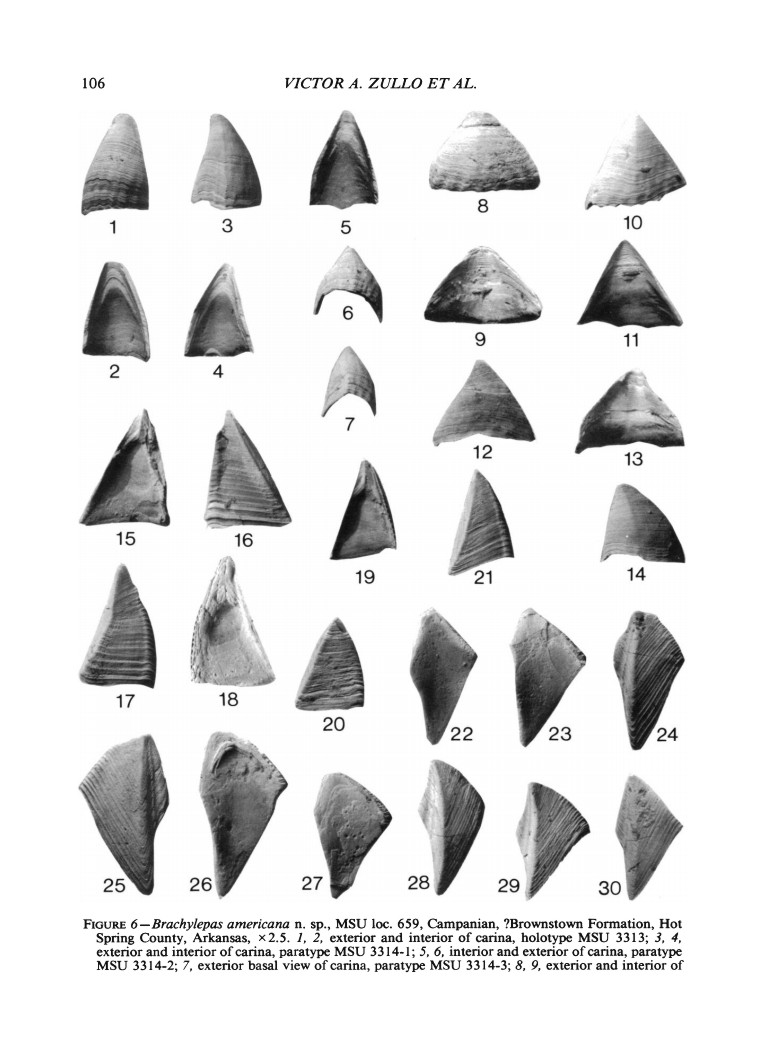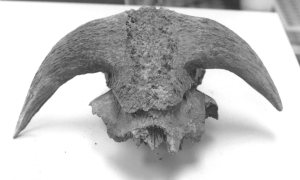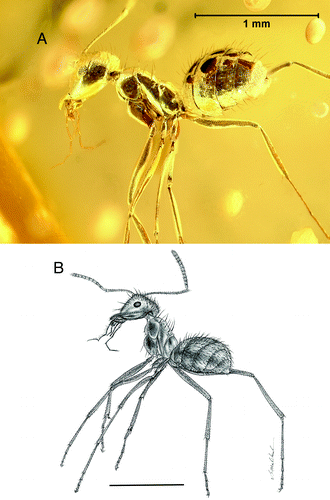Home » Mystery Monday
Category Archives: Mystery Monday
Mystery Fossil Revealed
Monday I posted a set of pictures showing an Arkansas fossil. Were you able to figure it out. Check below for the answer.
This skull and mandible comes from the Madrean Archipelago Biodiversity Assessment (MABA) website. I couldn’t find a good picture of an actual fossil, so I used this modern example instead. Below is a living version.
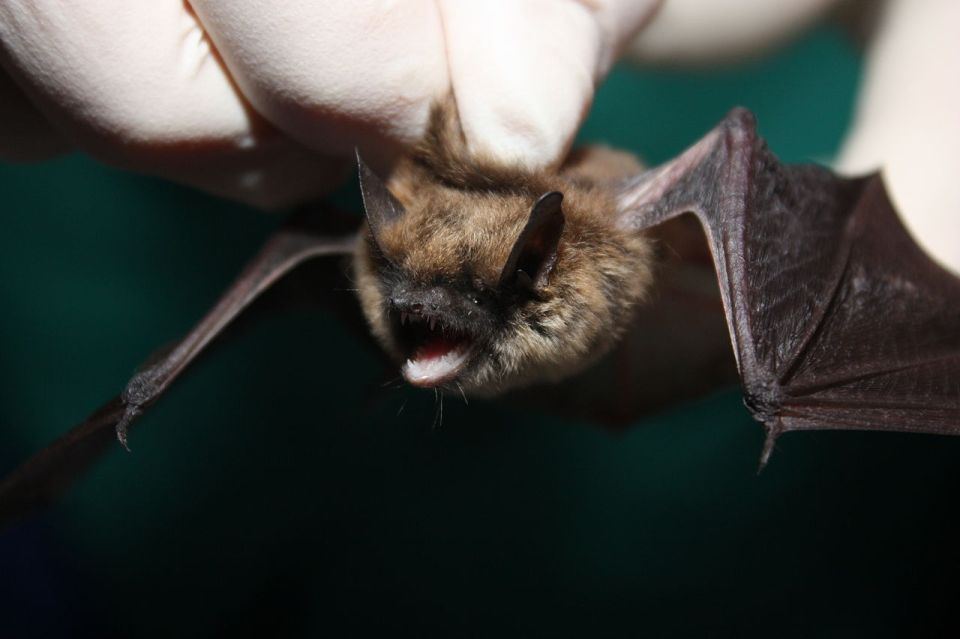
Myotis leibii, Eastern small-footed bat. Credit: Gary Peeples/USFWS
The skull is that of Myotis leibii, the eastern small-footed Myotis. Myotis bats are also called mouse-eared bats, the most famous of which is the little brown bat, Myotis lucifugus. The other fossil bat in Arkansas is the big brown bat, which is not in the genus Myotis at all. It is in the genus Eptesicus (E. fuscus specifically).
I have talked about E. fuscus before, where I talked a bit about bats in general. I didn’t go into their phylogeny at all, so I will talk about that here. Bats as a whole belong to the order Chiroptera, which is the sister group to a group called Fereuungulata. That group includes artiodactyls, cetaceans (whales and dolphins), carnivorans, and pangolins. Altogether, Chiroptera and Fereuungulata form the horribly named Scrotifera. Why do I say it is horribly named? Besides the fact that naming such a large group after scrotums is a bit odd, take a look at the simplified mammal phylogeny illustrated by Darren Naish.
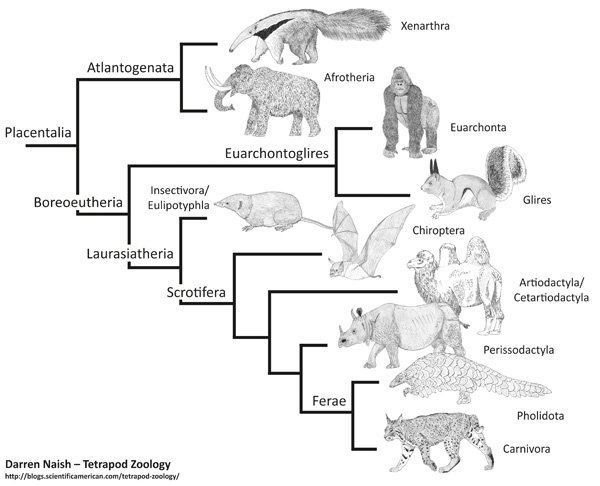
Notice what is NOT in Scrotifera. That’s right. Primates, such as us. Yes, we are more closely related to rats and squirrels than we are to bats, dolphins, or cats and dogs. We are also not included in the group named for a feature we possess.
Both Myotis and Eptesicus are Vesper bats, meaning they belong in the family Vespertilionidae, along with over 300 other bat species. When it comes to diversity, mammals could easily be described as rodents, bats and their less common relatives, seeing as how those two groups include 60% of all mammals. Vesper bats are in the suborder Microchiroptera, the micro bats. The other suborder, Megachiroptera, is composed of the fruit bats like the flying foxes. The two suborders are rather lopsided in numbers, with just under 200 species in Megachiroptera and over 1000 in the Microchiroptera. This is the traditional classification at any rate.
There is another phylogeny that splits it up slightly differently and gives them different names. Megachiroptera has become Yinpterochiroptera and includes the horseshoe bats in the group called Rhinolophoidea as well as the lesser and greater false vampire bats in the genus Megaderma. Everything else that was in Microchiroptera is in Yangochiroptera.

You can read more about it here, or in the original paper here.
So returning to the vesper bats, these include most of the bats people are likely to run into, which is why the bats in this group are sometimes called common bats. Most of the bats in this group have rather plain faces and are insectivores. Myotis leibii itself belongs in the group Myotinae, marked in the red box in the phylogeny below, which was also put together by Darren Naish.
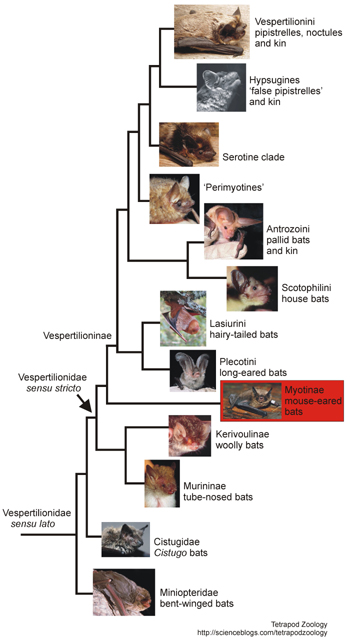
The interesting thing about this is that Eptesicus, the big brown bat, is in the serotine clade, up near the top of the tree and quite a distance away from Myotis, the little brown bat. Eptesicus is also sometimes called a house bat, but the house bats are in the group Scotophini, which while still in Vespertilioninae, is not closely related within the group. This is part of the reason common names can get confusing. just because the common names are similar and overlap doesn’t necessarily mean they are at all closely related.
M. leibii itself lives in forests throughout eastern North America, in spotty patches from Canada to Arkansas and Georgia. It is a small bat, weighing only about 5 grams and with a wingspan of less than 10 cm. Unusually for its size, it is long lived, living as long as 12 years and tolerates the cold better than most other bats, so spends less time in hibernation than other bats.
The fossil record of M. leibii is sparse, although the fossil record for Myotis in general is fairly good for bats. According to molecular data, the genus Myotis first appeared roughly 16 Mya, with the North American clade splitting off no more than 9 Mya. However, the actual fossil data indicates Myotis is far older, with the earliest known Myotis fossil being 33 Mya to the earliest Oligocene, although in North America, the record only extends to the late Miocene no more than 23 Mya. Interestingly, the fossil record for M leibii demonstrates a range far greater than the current distribution, with fossils being found as far as Oregon. In Arkansas, fossils are limited to one spot, which happens to be the same spot Eptesicus has been found: pleistocene deposits within the Conard fissure. If one looks in the original publication of Conard Fissure by Barnum Brown, one will find Vespertilio fuscus and Myotis subulatus, but both of those names have been changed in the intervening 110 years, to Eptesicus fuscus and Myotis leibii.
Monday Mysteries
It is long past time I resurrected Monday Mystery fossils. So to celebrate the season, here is a little animal whose relatives, or at least representations thereof, shall be widely seen over the next month.
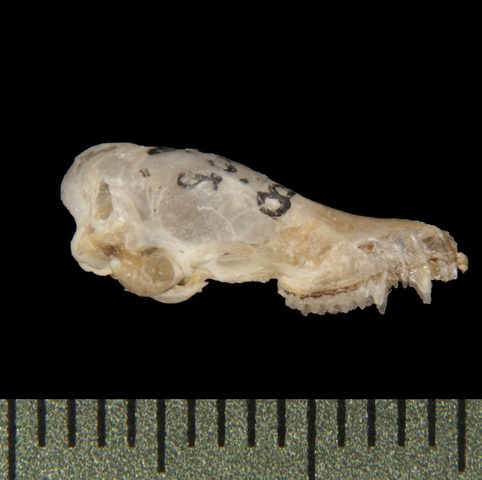
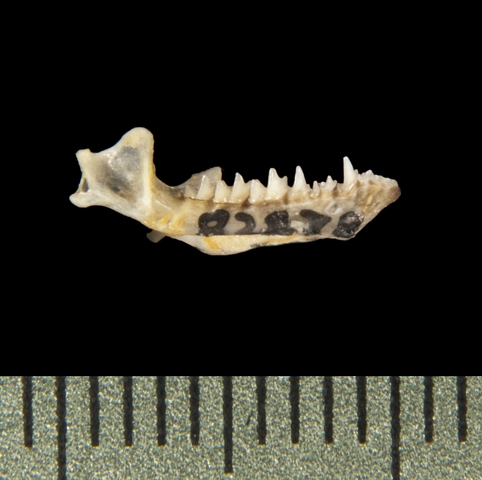
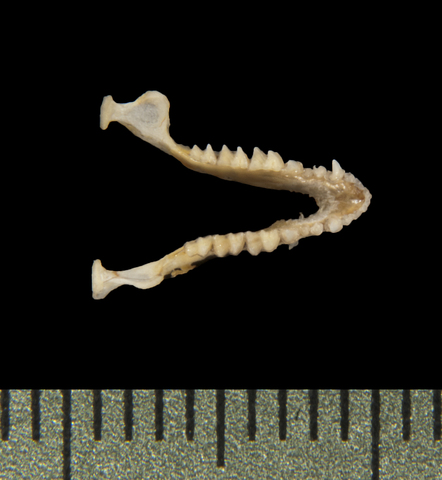
If you think you know what this is, please leave your identification in the comments. I will let everyone know what it is and where fossils like this have been found in Arkansas on Friday. Have a great October!
The Long Delayed Fossil Segment
A reader by the name of Allie Valtakis successfully identified the fossil last week as worm burrows and another reader further identified them as Serpulid tubeworms. Great job!
Here is the picture again for those who did not see it. The picture comes from Donald Hattin’s “Stratigraphy of the Carlile Shale (Upper Cretaceous) in Kansas: Kansas Geological Survey, Bulletin 156, 1962. Plate 13.

It is listed as Serpula semicoalita Whiteaves, encrusted upon fragment of Inoceramus cuvieri, middle part of Fairport (Loc. 37), x1/2, hypotypes, KU1202062J1.
In 1984, Norman Sohl and Carl Koch reported finding an unidentified Serpula species in Hempstead County, near Hope, in the Arkadelphia Marl, a Cretaceous limey mud well known for its shallow marine fossils. Numerous Exogyra oysters and Gryphaea have been pulled from the mud there, along with a variety of other fossils. On this particular occasion, they found, lithophagid borings, pycnodontes, Exogyra costata, Gryphaeostrea, Crassatella, Anchura, Discoscaphites, Clione, and last, but not least, Serpula. Sadly, they provided only a faunal list and not a single picture in the entire report. They provide a map on page three of the localities, but that is it. How one writes a report 282 pages long, consisting of one illustration, two tables, and 270 pages of lists of fossils without a single illustration of anything collected is truly a mystery to me. At any rate, here is the citation, the actual report is at the link provided above.
Sohl, N. F., and Koch, C. F., 1984, Upper Cretaceous (Maestrichtian) larger invertebrate fossils from the Haustator bilira Assemblage Zone in the West Gulf Coastal Plain: Open-File Report.
![Rudman, W.B., 2004 (July 27) Polychaete Worms (Bristle worms). [In] Sea Slug Forum. Australian Museum, Sydney. www.seaslugforum.net/find/polychaete](https://paleoaerie.org/wp-content/uploads/2016/03/polycheate.jpg?w=247&h=300)
Rudman, W.B., 2004 (July 27) Polychaete Worms (Bristle worms). [In] Sea Slug Forum. Australian Museum, Sydney. http://www.seaslugforum.net/find/polychaete
They are rather unusual for worms in that they are important biomineralizers. They make long calcium carbonate tubes in which they can pull themselves into when threatened. Unlike other tubeworms, serpulids even have a lid, called an operculum, they can close the tube with. While they are common in shallow marine settings, the pictures most people have seen of them have come from nature documentaries showing the ones that live near hydrothermal vents because they have an unusually wide range of thermal and pressure tolerances, with species living throughout the oceans.
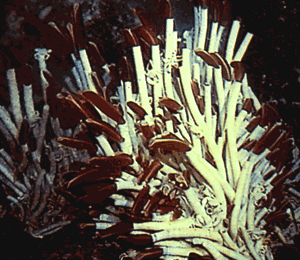
A colony of tube worms, some as long as 1.5 m, clustered around an ocean floor hot spring. (Photograph by Daniel Fornari, Woods Hole Oceanographic Institution.)
Serpulids don’t get nearly as big, with the largest modern ones rarely getting more than about 150 mm in length and 5 mm wide, although they cause more problems, seeing as they live in shallower water and like to attach themselves to boats. They will also attach themselves to clams, coral, rocks, and pretty much any other surface they can find.

By Nhobgood Nick Hobgood – Own work, CC BY-SA 3.0, https://commons.wikimedia.org/w/index.php?curid=6300216
The fossil record of serpulids goes back to the middle Triassic, but the only record of them in Arkansas is the one from the Cretaceous. There are reports of possible annelid tracks in the Ordovician rocks of the Ouachitas, but that would be too early for serpulids and without any fossils to back them up, the tracks could well be anything. Polychaetes make for terrible fossil makers, as they are mostly soft tissue and fall apart into mostly unrecognizable chitin pieces quickly after death, making serpulids unusual for the group. The tubes they make give them a far better chance at making it through the fossilization process, so they show up disproportionately in the fossil record compared to their kin.
Tubeworms like this are filter feeders, but some other polychaetes are carnivores, which is all that Hollywood has needed to turn deep sea tubeworms into this. Gotta love B-grade monster movies.
It seems that I will not be able to consistently get the explanatory posts out as timely as I would like for the mystery fossils. So what I think I am going to do in the future is to continue to put them on Facebook as mystery fossils, but I will skip the initial post here. So if you want to follow the attempts to recognize the fossils before I post them on the blog, follow the Facebook feed and get a jump on the blog posts. Speaking of the Facebook page, I have found the the later Google Chrome updates have somehow broken the Facebook link on the website, so the Facebook posts are no longer showing up on the page as they are supposed to. They work correctly on Internet Explorer, so I do not know why they aren’t working on Google Chrome. I am not a computer programmer, but I will see what I can do about that, although that may just have to wait until the revamp of the site, which I am planning. In the meantime, I appreciate your patience and thanks for reading.
Fossil Monday, A New Segment
Here is a new fossil for you to identify. I haven’t put up anything like it before, so you can rule out any of the usual candidates. I will put up the answer next Monday unless some early bird beats me to it. Good luck.

Mystery Monday, a Sticky Wicket
It has been a long time since I have posted a new mystery fossil. I will kill two birds with one stone today by revisiting a type of fossil that I have shown before, but for which I neglected to provide some specific Arkansas detail. See if you can figure out what this is and tune back in Friday to find out what I didn’t say last time.
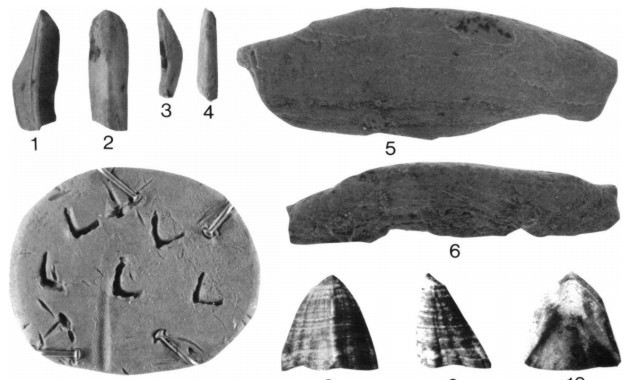
Mystery Monday, Halloween edition
I haven’t posted a mystery fossil this fall, much to my own disappointment. But I have the perfect specimen for this week. With Halloween this Saturday, I had to post this one. See if you can figure out what it is. Check back Friday for the answer.
I couldn’t find a picture of the Arkansas fossils, so one from Ohio will have to do.
Getting Antsy for the Answer to last Week’s Mystery Monday?
Last week we posted a new fossil. Were you able to figure it out?
This particular picture is of the ant, Nylanderia vetula, caught in Dominican amber. Dominican amber is from the Miocene, currently thought to be about 25 million years old. The fossil ants from Arkansas are a bit different.
In 1974, ants were found in amber collected near Malvern, Arkansas, from the Claiborne formation, which is listed as being from the Eocene, roughly 45 million years ago (give or take 3 million years). According to the Arkansas Geological Survey, the Claiborne is a series of fine sand to silty clay layers, with interspersed layers of lignite. The lignite and amber are clearly indicative of terrestrial environments, although there are some marine sediments within the formation. A number of fossils have been found in the formation, including fish and reptile bones and teeth, leaf impressions, trace fossils, and of course, wood and amber.
The specific ants that have been found were identified as Protrechina carpenteri. These ants are in the group Formicinae, one of the more common ant groups. Interestingly, the Eocene ants were anything but common. Ants during this time shifted from the earlier ants to a more modern collection of species. They were quite diverse, with Phillip Ward reporting that David Archibald claimed some of them were the “size of small hummingbirds”.

Titanomyrma lubei (not from Arkansas).
Images of our Arkansas fossil ant are hard to find, as in, I couldn’t find a single image. However, if you want to see the real thing, go to the Harvard Museum of Comparative Zoology, where Antweb.org reports it is being held. Yet another Arkansas fossil in the hands of another state.
Mystery Monday
Time for a new Mystery Monday fossil. The fossil on display here was found in Dominican amber, as well as Russia. But it has also been found in Arkansas and played a role in our understanding of the evolution of this group of animals. Leave your identifications in the comments section and come back Friday for the answer.
Basilosaurus, the Bone Crushing Whale That Was Mistaken For a Lizard
Last week we saw this vertebra and lower jaws of Basilosaurus.
The history of Basilosaurus is intimately tied to Arkansas. Alabama and Mississippi may have claimed Basilosaurus as their state fossil (and indeed the fossils are much more common in those states), but it was an Arkansan that found them. Judge Bry found some bones in the Louisiana portion of the Ouachita River in 1832 and sent them to Dr. Richard Harlan at the Philadelphia Museum. After examination of these bones, along with more bones sent by Judge Creagh from Alabama, Dr. Harlan noted similarities with plesiosaur vertebrae, only twice the size, so in 1834 he named the animal Basilosaurus, king of the reptiles.
In 1838, more bones were discovered in Arkansas, near Crowley’s Ridge. E. L. Palmer published a brief note on them in 1839. Meanwhile, Dr. Harlan had taken his bones to the United Kingdom to see the esteemed Sir Richard Owen, the most prominent paleontologist of his day (even today, he is considered one of the most important researchers in the field). Sir Owen found that the bones were not from a reptile at all, but from a whale. Therefore, he proposed changing the name to Zeuglodon. However, the rule of precedence requires the first name to take priority, so Basilosaurus it is.
Basilosaurus has an important place in the study of whale evolution. In addition to being the first primitive whale identified, Basilosaurus was the first true whale that was an obligate aquatic animal. Since its discovery, several other species have been found, but they all still retain enough limb function to move, however awkwardly, on land. Basilosaurus, due to its size and having no functional limbs other than some small flippers, would have been unable to move on land. As can be seen in the chart above, Basilosaurus was not the ancestor of modern whales, though. It appears that Dorudon, a close relative, had that honor.
Basilosaurus was a huge animal, reaching more than 15 m (50 feet). Neither it nor Dorudon had the forehead melon characteristic of modern cetaceans, which indicates it likely did not have echolocation, but did have very powerful jaws, clearly indicative of its carnivorous diet. A recent (this year) study found that Basilosaurus had an estimated bite force of 3,600 pounds, giving it the strongest jaws of any mammal yet measured.

FEA analysis of a Basilosaurus skull. Snively et al. 2015. http://journals.plos.org/plosone/article?id=10.1371/journal.pone.0118380
There is a bit of a problem saying how old Basilosaurus is. The original fossils from 1832, as were the Arkansas fossils, were found in the Jackson Group, a series of intertidal to estuarine and shallow marine sediments of Eocene age, around 37-34 Mya. Another set of fossils from Crowley’s Ridge was found in 2008. However, according to marine mammal biochronology estimates, Basilosaurus should have appeared around 44 Mya. However, fossils do not generally record the first appearance of an organism. Thus, the most likely explanation is that Basilosaurus evolved roughly 7 My before the fossils we have found. The only way to solve this conundrum is to find more fossils, so get cracking.






